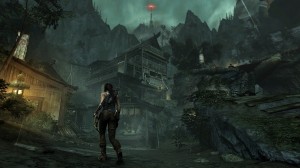
In the beginning, who was Lara Croft, and what events lead her on the path to becoming the iconic heroine we know as the “Tomb Raider”? This has long been a difficult question to answer as there has always been very little information provided on the subject. However, this obvious gap in Lara’s past has presented the development team at Crystal Dynamics with a unique opportunity to not only answer these questions, but also reimagine the series for the modern gaming world.
Lara Croft is 21 year old archeological graduate out on her very first expedition. She doesn’t yet hold a lot of experience, but set abroad on the ship Endurance, Lara is accompanied by a group of adventurers that have set out in search of the Lost Kingdom of Yamatai. They are not the first to set their eyes on this prize as there were many to come before them, all of whom failed in their search. It is for this reason Lara is not willing to retrace those well tread footsteps, and instead chooses to argue their navigation plan with Dr. Whitman, the lead archaeologist as she believes the answers they require instead lie to the east, hidden within the infamous “Dragon’s Triangle”
This was a dangerous theory to pursue, and with no clear evidence to support her ideas, it was a decision that quickly stirred controversy amoung the crew. However, the final word came from Roth as he was the Captain, and whilst his opinion may have been questionably biased given an existing relationship with the Croft family, he ultimately chose to ignore Whitman’s advice and side with Lara. This was a decision that could only lead to trouble, and it was not long after their trip to Eastern Japan had even begun that it quickly turned sour when an unexpected and violent storm tore their ship in two, and left the survivors stranded on an isolated island.
 If the narrative structure is starting to feel a little too familiar by this point, don’t worry. Whilst the reboot certainly shares a lot common ground with already existing games and film, it will quickly become apparent to players that this reimagining has it’s own identity to establish. The world of Tomb Raider is dark and intriguing, and whilst Lara may appear physically competent in her actions, it is also evident that she consistently struggles with her own limitations. It’s clear the designers intended to portray a genuine character that feels more human than action hero, and yet Lara also holds a relentless quality one can’t help but admire.
If the narrative structure is starting to feel a little too familiar by this point, don’t worry. Whilst the reboot certainly shares a lot common ground with already existing games and film, it will quickly become apparent to players that this reimagining has it’s own identity to establish. The world of Tomb Raider is dark and intriguing, and whilst Lara may appear physically competent in her actions, it is also evident that she consistently struggles with her own limitations. It’s clear the designers intended to portray a genuine character that feels more human than action hero, and yet Lara also holds a relentless quality one can’t help but admire.
The beginning of the game will have players learning just as Lara does after she awakes on the island, and in this respect the tutorial masks itself into the story quite nicely. This learning process will establish a majority of the gameplay mechanics to the player in a natural order that makes sense and does well to set the tone for the game. It’s an experience that has clearly been well designed and fits well with the cinematic structure of the experience.
Does the game remain open to exploration like it’s predecessors or does it take the route of a cinematic action game? Fortunately, the answer to this question is both, and it is actually a design decision that turned out surprisingly well. Tomb Raider is a game that is incredibly well paced, and it does an excellent job in capturing the players attention from beginning till the end. However, the game also features a base camp system that provides various pit stops for upgrades, abilities and fast travel.
What this base camp system implies is a semi open-world experience that gives players the ability to progress through the story at their own pace and to incorporate some minor role-player elements that encourage exploration and character development. The world of Tomb Raider is filled with many collectible artifacts, character logs, and of course hidden tombs which can be explored for weapon upgrades and large amounts of salvage. It’s a lush and captivating island landscape that is not overly large but well designed and entertaining for players to explore.
As players progress through the experience, Lara will be consistently accumulating XP from various actions. When the player has earned enough XP to unlock a skill point, they can then return to one of strategically placed camps to unlock a new character ability. In a similar fashion players will also be collecting what’s known as “salvage”, a general currency that can also be taken to a base camp and alternatively exchanged for gear enhancements. It’s not that these particular features are incredibly developed, but they do add a certain depth to the experience that encourages exploration without ever feeling as if you are forced into something.

Following in turn with the core theme of exploration was the idea that Lara’s origin story would be heavily associated with the need to survive, and initially this idea was followed through with the introduction of a hunting mechanic. However, this concept quickly became redundant with the inclusion of additional game mechanics that worked to contradict the survival theme. It honestly felt as if Lara should have been hunting for food, patching her wounds and perhaps using some type of compass/map combination to locate hidden treasures. Instead, the gameplay focus gradually moved in the complete opposite direction with mechanics such as regenerative health and the survival instincts vision, and it’s not to say this damaged the overall experience, but we can’t help but feel the player’s connection with the character could have been deeper given alternative design choices.
With all that being said, it’s undeniable that one thing Tomb Raider does exceptionally well is gameplay. It’s an experience that empowers the player to feel as if they’re in control and it’s simply incredible how the action can be presented in such a cinematic fashion without it feeling as if the game is also trying to take that control away. The bow and pick axe are perfect examples of player empowerment as both of these tools can be upgraded to interact with the game environment in new and intuitive ways.
The introduction of the bow is a concept that has been remarkably popular in many recent games. However, what Tomb Raider does to separate itself is demonstrate how this weapon is capable of being used for more than just killing. Just as the pick axe that is used for traversing the environment in a fantastic manner, it can also be turned around and used as a melee weapon. These abilities are improved with upgrades that actually change the way you play and interact with the environment, and it also helps to re-enforce that Lara is not an action hero, and just someone trying to survive.

Visually, Tomb Raider is a remarkable achievement, and it is especially surprising how fantastic the console versions look given their “technically” out-dated hardware. The character models are very well detailed, fire interacts in a magnificent way with the environment, and the island is both diverse and beautiful in its visual design. However, it might be surprising to learn the greatest accomplishment in the game’s presentation lies within the sound design as the Composer actually had a unique instrument especially built for this wonderfully inspired soundtrack.
It’s almost not worth mentioning the multiplayer as it’s clearly a mode that’s been tacked on to keep players from trading their copies away. It’s uninspired, and it doesn’t really offer anything new to give the package a competitive edge in an already saturated genre. The concept of applying a vertical aspect to competitive multiplayer was once an exciting idea, but this is something the Uncharted Series has already done successfully and better. The gameplay just doesn’t translate well, and the framerate often comes to a complete halt on far too many occasions. However, it is for all these reasons that we can easily dismiss the mode as not applicable to the overall review score as we don’t feel it hurts the excellent single-player campaign what so ever. I wouldn’t waste your time.
Starting with its initial concept, this reboot was always about going back to the beginning in order to bring a new depth to what Tomb Raider was about. It was to be less about a busty gunslinger and instead focused on an eager young adventurer out on her very first expedition. This would be the narrative that re-introduced players to Lara and allowed them to experience the events that lead her on the path to becoming the heroine we know so well. The lack of canon available on Lara’s past provided the perfect opportunity to explore her origins, and the focus on a Japanese history not so well known in gaming worked exceptionally well to keep things interesting. It was slightly off-putting to see yet another radical cult driving the plots main antagonism, but fortunately it ended up naturally suiting the story without ever falling into the realm of being too ridiculous.
Tomb Raider is an origin story that was designed to make you care, and with an outstanding performance from Camilla Luddington and the rest of the cast, we believe Crystal Dynamics achieved exactly what they set out to do. It is unfortunate that the game design never fully embraces the survival theme, and it remains slightly unsettling the way Lara moves so quickly from the emotional distress of her first kill into the headshot happy gameplay that the game delivers so well. It is worth acknowledging that this point is briefly addressed later in the game, which does help to improve upon the mixed translation between narrative and gameplay. However, as a whole the game still comes together exceptionally well to deliver an emotional story that is certainly worthy of the Croft legacy.














